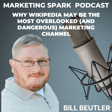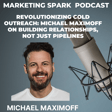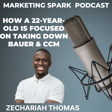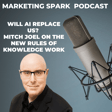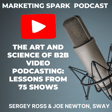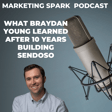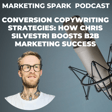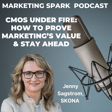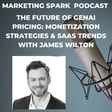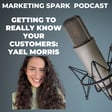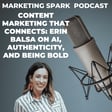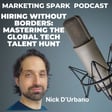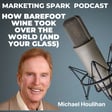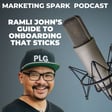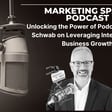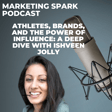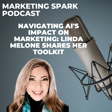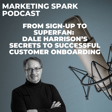Standing Out in Competitive Markets
00:00:07
Speaker
Every market is teaming with competitors. At a high level, they offer the same products or services and the same features. But how do they differentiate themselves? What are the keys to establishing themselves as market leaders and as important, keep their leadership position? It is undoubtedly a huge marketing challenge given the competition keeps on coming. The industry landscape changes and new players launch on a regular basis.
Introduction to Carrie Sanderson
00:00:35
Speaker
On this episode of Marketing Spark, I'm sure we'll get some great insight from Carrie Sanderson, Chief Marketing Officer with Typeform. Welcome to Marketing Spark. Thank you so much. I'm thrilled to be here, Mark. Why don't we start with Typeform 101? What does Typeform do?
Typeform's History and Approach
00:00:51
Speaker
Who does it serve? And how does it deliver value around customer engagement and lead generation?
00:00:57
Speaker
Typeform has been around for just about 10 years. It's our 10-year anniversary this year, a Barcelona-based company, but we have customers all over the globe. We really are, you know, this is an often used term, but the gold standard, right? It's 10 years ago when Typeform was launched, they just changed the way that you can interact with folks online, whether that's a forum or a survey, because it's really conversational-based instead of that wall of questions. And it's been that kind of benchmark ever since of what a good interaction can look
Customer Engagement and Lead Generation
00:01:26
Speaker
We help our customers of all shapes and sizes. We've got everyone from one person, founder, does everything, companies using Typeform really well, all the way to very large customers who use us across the board where they want to have a great experience for that interaction with their customers.
00:01:45
Speaker
It's really a lot of folks use us for, you know, to grow their business. It's a lot of lead gen. It's the first interface when you're making a contact with the customer. How might you provide a great experience, get them, tell them a little bit about yourself and kind of get that zero party data that is so coveted and more important right now.
Carrie's Journey to Typeform
00:02:03
Speaker
Typeform does that in a way that really feels human and it makes people want to share and be a part and engage with your brand.
00:02:11
Speaker
We also have VideoAsk, which is more of a video-based, same idea though, product. And some folks use us for like a chat, although it's not our primary use case. Some folks use us that way. For almost a half a billion digital interactions every year, and then of course integrating with all the tech tools that you would expect.
00:02:29
Speaker
We are, I've been here for about a year. It's been a really fun ride. You know, it's always good to work on a product where that customer, instant customer love is built in. And you know, it's just, it's my job to work with the team on where we go from here.
00:02:42
Speaker
Aside from having a fantastic excuse to visit Barcelona on a regular basis, what drew you to Typeform? What was the challenge that you were looking for? I mean, this is a well-established brand. It's one of the market leaders, if not the market leader. What personal professional challenges were you looking to tackle by working for a company and leading the marketing team at Typeform?
00:03:03
Speaker
So for me, I think it was three different dimensions, right? There's the dimension of, I feel like I need to have a passion for the product that I work on. And Typeform has that sort of B to B to C element where you get to get the instant reaction from the end user, the person that responds to that form. We feel that every day because we have a very large viral growth when people fill out a Typeform for the first time. What was that experience? That was amazing. Like when you have that customer love built in,
00:03:33
Speaker
they click and they want to find out more. And then we say, well, maybe you have a use case for type form. So that grows our engine. I love that. That built in emotional, instant connection to a brand is really important. So I love that about it. I also love the size of which type form is like this idea of we're scaling into, you know, we've been very successful organically, but now's that time to really think about a marketing strategy.
00:03:57
Speaker
a positioning strategy that will really let us scale and kind of tell the whole world more about what Typeform can do. And then for me personally, it's a great challenge just to be able to think about this global remote first world that we're in and leading a marketing team that is that distributed across.
00:04:15
Speaker
You know, I mean, it's nine hours difference from my creative team. How does that work? So it's a leadership challenge for me as well. I checked all those boxes, great leadership team. So it's been a fun year so far and I'm looking forward to many more.
00:04:28
Speaker
Looking back over the past year, amid very uncertain, interesting times, what are the biggest accomplishments list of things that you wanted to do and things that you've done so far?
Demand Creation Strategy
00:04:38
Speaker
I think like as any company that's scaling the way that type form is, you know, we closed our series funding in a series C funding in January. And that was a big event for us because it gave us
00:04:49
Speaker
a little bit more of the resourcing that we need to be able to push on marketing levers that we may not have typically pushed on. Some of the higher level, we've been mostly capturing demand. I know you've had Chris Walker as one of your guests in the past, but this idea of what's the difference between demand capture and demand creation.
00:05:05
Speaker
So really working on the team and bringing in the right leaders and skill sets to think about what does it mean to create a brand in the ecosystem that we put in front of people who may not even know they have a problem, who may not even realize that type form can elevate how they show up in the world. But those that don't know about us, we haven't really been touching that market at all. And so I've been working on sort of that top of funnel marketing beyond the kind of typical demand capture that you might find at a company our size.
00:05:34
Speaker
So, expanding that a bit and then thinking through the whole life cycle. What is that customer journey? We always keep customer front and center, but thinking through the different mindsets that people may have when they encounter type form. Whether it's a respondent who fills one out for the first time or somebody who's searching, I need a form or somebody who's listening to this podcast.
00:05:53
Speaker
How might they come into our funnel? Are we meeting them where they are? And what kind of content do we have to kind of explain how we may or may not be a great fit to help them grow their business, engage their customers.
Strategic Messaging and Stakeholders
00:06:07
Speaker
Off the top, I talked about standing out from the crowd and competitive differentiation. And as you probably know, I'm a huge fan of positioning and messaging. And I'm curious about type forms approach to strategic messaging. How does it ensure that its positioning remains clear and differentiated?
00:06:28
Speaker
So I think a couple of things. For me, when I joined Typeform, we really focused on the respondent experience, right? And that's a very much of a core of who we are. And so as I evaluated when I joined, like where are we missing out possibly on our positioning? Where can we amplify what we benefit?
00:06:47
Speaker
there was really a couple other stakeholders that we weren't, didn't have great messaging about speaking to them. The first one being the creator, right? The person who asked to actually build the type form, whether you're a demand gen person or somebody in HR, whatever role you play, you're the one that has to sit down behind the computer, you know, figure out how it integrates with all the other software. Have we really been spending enough time in our positioning thinking about them as a stakeholder? So it's not just a respondent experience. If it's hard to build, that's no fun for me, right?
00:07:14
Speaker
We've made Typeform easy. It's so easy even I can do it. We've made Typeform easy for anyone to get started and quickly build a form.
00:07:24
Speaker
The second thing is the business itself, the business value of Typeform. I think we have an opportunity and we have been pushing more around how can Typeform actually help you grow your business and contribute to their bottom line in your goals, whether those are revenue goals, loyalty, other type goals you may have.
00:07:45
Speaker
We have a lot of information from our customers about how we do that. We just have not been strategically messaging that in the market. And so part of it is that three-legged positioning tool, really thinking about the value we provide to the various stakeholders. So I've been working with my internal team to balance that out, to say we've got great proven respondent-level messaging. How are we thinking about what a creator, somebody who has to build this thing, what the value they are going to need to derive from Typeform? What are their pain points? And then similarly, as a business person,
00:08:14
Speaker
You know, if CMOs aren't really thinking as much about, is it easy to build? They just want to know what it's going to deliver. So that's where we're pushing out strategically from the messaging perspective.
00:08:24
Speaker
Yeah, one of the things that I think that is interesting and challenging is the idea that you're developing positioning and messaging from multiple stakeholders in different use cases. There are parts of the market that are going to want a completely different message than other potential customers. So how do you manage that mix and make sure you're talking to the right people in the right way?
Focusing on Marketers
00:08:46
Speaker
It's a great question. I'm a big fan of knowing what you're not going to say and who you're not going after is just as important as trying to go after everyone. And when you have a horizontal product like Typeform, it's tempting to try to speak to everyone, right?
00:09:02
Speaker
What we do is there's definitely a generalized message, but what we're working on right now, marketers are definitely a key, like everybody wants to talk to marketers, but marketers are a very key audience for us because they're the front lines of how do you get business growth? They typically manage the website, which is a lot of where people will host type form as that really nice user-friendly interaction layer that then feeds into their CRM. So as far as our primary focus right now, it is marketers, but it doesn't mean that we don't have
00:09:32
Speaker
someone comes to us from another discipline or job title that they still can't find what they need but we know where we're proactively marketing and creating that understanding demand is definitely with marketers. As we build out that muscle and we learn to use our own type forms for feedback for people about how other innovative ways that folks are using us then we can we can start to expand.
00:09:54
Speaker
Trying to be everything to everyone is a road to mediocrity in my mind, at least at the stage where we are. There's definitely an opportunity for us to build moving forward, but right now we're very much in focus mode.
00:10:08
Speaker
One of the challenges of positioning is that the competitive landscape changes all the time and certainly the market in which Typeform plays is active and interesting and ultra competitive. I'm curious about
Competitive Research Methods
00:10:26
Speaker
how Typeform conducts competitive research to identify new and interesting challenges and as well as the incumbents and how does it monitor what competitors are doing from a marketing and sales perspective because there are camps of people that say don't pay attention to the competition, focus on your customers, focus on what you're doing and that's the most important thing and the other camp will say
00:10:47
Speaker
Listen, you got to monitor the competition because if they're doing interesting things, if their marketing or sales is resonating and yours is doing as well, then you got a problem. So from a marketing research perspective, what are some of the tools that you use? What are some of the approaches that you take to make sure that you know what the competition is doing and you're being proactive as opposed to react?
00:11:10
Speaker
I'm definitely one of those people that's not, I'm not in either one of those camps. I'm kind of in the middle of, you know, you can't completely ignore competition because then you're not really putting yourself in the customer's shoes. The customer, there's very few customers out there who aren't going to evaluate, you know, what their options are. And that's the lens that I like to approach competitive analysis from, which is how are our customers evaluating us? How do they stack up?
00:11:35
Speaker
where do they put us in a consideration set in a value-based offering so from a competitive research perspective there's really a couple different approaches the first thing is we you know when i joined i wanted to understand you know with my my job is to grow this brand and to build a business where are we you know i'm new i don't understand you know
00:11:55
Speaker
How many people know about us? So we did a brand health survey starting in the US to see, you know, what is our awareness levels? Where is it relative to our key competition? What is the value proposition? So really getting an understanding of how much our customers, you know, would they recommend us for those who'd heard of us, what kind of NPS score do they give? And that gave us a pretty good feeling of in general, how we were performing in the marketplace.
00:12:20
Speaker
Then, secondarily, we have a really good strategy and research team here that, you know, if we need to do a deep dive on the competitor, they can. And then, you know, ultimately, from a go-to-market perspective, if we're making changes to offerings or pricing or positioning, and even when we did our first ad campaign, you know, I definitely want to know, what are other ad campaigns looking out there, looking like out there? What creative are they saying? What messaging are they pushing in so that we
00:12:45
Speaker
can stay true to our positioning but also differentiate, also show up in a way that breaks through that sea of sameness if you will that can often happen in these categories. So it's a mix but my first thing was I needed to know where we were relative to the competition because whenever you're in a company you live and breathe it every day so you think everybody must know who we are but not always especially that just gives you a feel for who you still have to educate and then
00:13:09
Speaker
You know, I do want to understand, you know, if news is coming out, that kind of thing, how are they positioning? And then when we have big pushes, I want to make sure that we're not showing up with the same language. It's definitely pay attention, but I definitely also don't do a react mode. That's very unhealthy, not only for your business, but for your team, right? Because you want them focused on building strategic plans. And if you're always reacting,
00:13:34
Speaker
it can create a lot of lack of effectiveness on what the team's trying to do.
00:13:40
Speaker
I think it's an incredibly huge challenge these days in terms of the competitive landscape. Bill Gates once said that, your next big competitor is working in the garage right now. And if you look at the B2B SaaS world, I mean, it doesn't take much, relatively speaking, to launch. Or in a cooking space in Barcelona, right? Yeah, exactly. Yeah. And you asked about tools. We don't have this here yet, but I mean, I do, like Crayon was an amazing tool that we've used in the past. There are competitive monitoring tools that
00:14:08
Speaker
that I think as we grow, we haven't invested in it yet, but we likely will start investing in some of those things. We do social media monitoring, of course, and some share voice PR type tools that we use. You need to have that just to understand what's happening in the marketplace and look for signal that you might not otherwise catch. But there's so much greenfield really in terms of what we're doing at Typeform that it's okay for us to not be... I want to be obsessed with the customer and what they're thinking and
00:14:38
Speaker
how they buy and how they evaluate. And by nature, you'll pick up some competitive feed from that. But I want to be customer obsessed, not competitor obsessed.
00:14:49
Speaker
We're living in very interesting times right now. The market has seemingly slumped overnight. What was a very robust marketplace has gone soft and there's a lot of fear out there. There's also summer. There's obviously an obvious slowdown during the summertime. I'm wondering what your take is in terms of type form as a valuable marketing tool for brands amid slower economic growth and how you're marketing
00:15:19
Speaker
has changed to reflect the economic landscape? That's a great question. It's a really challenging time out there right now, speaking about customer-centric. Every penny matters, especially we have a lot of SMB customers who are evaluating every dollar they spend and trying to understand the value. From Typeform's perspective,
00:15:40
Speaker
We offer an amazing experience, right? It's not a one-way form, a wall of questions that doesn't really give people an emotional connection to your brand. When you experience that, you lose customers. And we know that we have a much better response rate, a much better quality of data rate, still rate, when people use Typeform because it feels more personal, you can make it feel like your brand, you can create that loyalty. I think it's even more important now because every customer matters more than ever.
00:16:09
Speaker
So it's tempting in a market like this to pull back on some of these things and say, OK, I'm going to cut this this here or cut that there just to save.
00:16:19
Speaker
And it's a challenging decision. It'll be different for every business. But now is the time in these challenging times to think about the experience that you're giving to your customer, to stand out, to differentiate. We know through our own customers telling us that we do that. We do that, whether it's type form or video ask. This way of making a customer feel special or feel like you took time to care about their experience can be a differentiator that can make the difference between
00:16:47
Speaker
keeping a loyal customer, winning a new customer, and they matter even more. When the water's high and everything's good, you can let some of those customers float downstream. But right now, the water's low, the rocks are showing, how do you keep them in your boat, so to speak?
00:17:03
Speaker
Yeah, retention is huge and everyone talks. That's a huge theme these days. At the Saster conference recently, I think someone from Andreessen Horowitz was talking about that is the key focus for B2B SaaS companies these days. On the flip side of the economic landscape discussion,
Adapting to Economic Challenges
00:17:20
Speaker
What's happening with Typeform these days? You raised a round, a big round in January, so you've got some runway and you've got some financial clout, which is an awesome thing to have when the competitors may be pulling back on their marketing. Has Typeform's marketing shifted or changed at all over the past few months because the landscape has changed? And this can reflect not only how the channels that you're using or the money that you're spending or even the approach that you're taking, what's it look like from the Typeform perspective right now?
00:17:50
Speaker
Like every good marketer right now, we have all evaluated, okay, so are we being as effective as we can, as efficient as we can with the company resources? Having that most recent round of funding absolutely helps. There's a race car quote that I won't get exactly right, but on a sunny day, it's hard to pass cars. But in the rain, and if you're well-suited, you can really make a lot of ground.
00:18:15
Speaker
we're lucky i kind of visualize that that extra investment that that level of confidence or whatever that we have that behind us and it's my responsibility to make sure we invested well so absolutely looked at everything and then thought about
00:18:32
Speaker
As I said earlier, where might we be getting our message out? Where could we be getting our message out to those who have not yet heard of type form or don't understand the value that we can provide, especially in this condition? So actually our investment levels have increased and we are looking, especially in those like reaching out to folks who may not have heard of us. Um, and that's in that acquisition side, but also on the retention side. So making sure we're really caring for the customers we have.
00:18:58
Speaker
to your point, adding a little bit more of value-based messaging to them, reminding them with other stories and inspiration about how Typeform is a valuable tool for them, and how we connect with their other tools. We're also doing our own, like, do we need all this software kind of thing? And just like we'd be on somebody else's looking at their marketing tech stack,
00:19:20
Speaker
They may be saying, well, what do we just type form for, right? So how do we ensure that we play well with others? You know, the integrations that we have with your CRM or with your web provider, making sure those are all really five star experiences that they're easy to use and talking about that.
00:19:39
Speaker
Our actual total investment is increasing and in, I would say in acquiring a new kind of customer who wouldn't normally find us through our organic revival channels and then retaining and even expanding current customers is where we're pushing a little bit. You mentioned Chris Walker earlier in the conversation. He talks a lot these days about dark social and dark web and
Measuring Marketing Impact
00:20:03
Speaker
big challenges for marketing leaders is that not all your marketing activity can be quantified. I call it in some respects leap of faith marketing because you're doing these things, but all these conversations are happening and you can't measure them. So as a marketing leader, what's your take on dark social and dark web in terms of
00:20:23
Speaker
their impact on the buyer's journey. And how do you communicate that to your leadership team when they come to you and say, Carrie, how's our marketing performing? What are the metrics like? What are the KPIs? What do you say? How do you approach this? Well, it's interesting because I've been a marketer for, you know, quite a while. And so I call it old school marketing.
00:20:44
Speaker
you know the first marketing campaigns i ever ran there was no way to digitally immediately measure you know how that worked you would have an ad in the sunday paper you might have displays up all over the country you know back in my cola days so it's a little bit of that it reminds me of that you have to really it forces you to really think through that customer journey and really think about um the experience that providing and have trust in
00:21:10
Speaker
in what you're doing. If you put the customer front and center, you really understand that you have to put it out there. What's the beauty of it now is you can do that old school marketing, but you still have the, when people come to you, then you can pull them into the traditional digital channels, which are easier to measure right now.
00:21:26
Speaker
And it's a conversation that I'm having, obviously, with the CEO and CFO and the leadership team around cost of acquisition being an aggregate thing to think about, the long-term value being an aggregate thing to think about versus measuring each individual channel or email chain. We should be looking at that absolutely, but how do we look at it holistically?
00:21:49
Speaker
And the idea of the rising tide floats all boats, right? So we actually have seen this with some of our new PR efforts that we've been putting in place when we get these, even our series C funding, you know, which was picked up. We saw an increase in traffic. We saw an increase in folks signing up. And so when you have those little signals,
00:22:10
Speaker
as a marketer, you amplify those internally as much as you can to say, see? And then, you know, we kind of we kind of do this baseline, what might you expect from this? And then if it's running at the same time, how much incremental did you get over that? It's it's art and science. It's actually a really fun part of marketing, especially as like I have a lot of brand strategy, brand positioning background. And I know the value if you do it right is something you'll never be able to fully measure.
00:22:37
Speaker
but it's out there. It's not an easy conversation, but it's one that the leadership team at Typeform trust me to make. I made sure that they had that mindset before I joined. That was important to know the kind of marketer I am. There's going to be things I'm doing that will not be able to immediately directly measure. So I made sure to ask that question before I joined the company. So I've got the support a little bit built in there.
00:23:00
Speaker
It's really interesting that you equate dark social and dark web to old school marketing because at one point in time, a long time ago, I was a newspaper journalist, ink stain newspaper journalist. And we depended on these display ads and classifieds to generate revenue, but they had no way of knowing, of quantifying exactly what our reach was. We could say our circulation was a hundred thousand or 200,000. Same thing for billboards and radio and magazine ads.
00:23:27
Speaker
And it is interesting when you think about it. Sunday coupons, Mark. Those Sunday coupons. I still remember sitting when I was just my very first job as a brand associate. Six weeks ago, this Sunday coupon dropped. What was the retention rate? What was the value? The different test markets that they would fall in. I mean, it's a little bit old school. You have to trust it and do your customer research upfront. You can't wait till the A-B test can't be your research.
00:23:53
Speaker
I think that's an important point is that the more, you know, the customers, the more, you know, the channels where your marketing can resonate, the more you can do this type of marketing that, that you're not going to quantify taking a deeper dive into type forms marketing.
Content Strategy and Customer Needs
00:24:07
Speaker
What are some of the key levers that you're pulling these days? You know, is it things like content marketing? Obviously you're you've embraced PR podcasts. What are some of the things that, that you're really leaning into from a marketing channel perspective?
00:24:21
Speaker
I would say to me it's as much about an integrated approach as it is which channel in specifics. Obviously, the key channels, we need to make sure that our website, it's our second largest marketing asset, the first one being our product because it does drive so much viral growth, is our website in good shape and is it really optimized for people that come to the journey? Those foundational things, the foundations of
00:24:43
Speaker
of our SEO program and our paid program. But what's even more important to me is how it's integrated. So if we're starting to do some advertising, how does that messaging, how does that creative flow through the whole funnel? So we are, we're leaning in on channels we haven't really used before. As we are thinking about our content strategy, are we thinking about it in terms of
00:25:03
Speaker
a twelve month calendar of what are customers most interested in what what kind of feedback are we getting where we can be the most helpful to our customers you asked me earlier about. You know what are we doing right now for it for our customers in this downturn you know we're creating a whole content series around specific to smb specific to that initial experience that can give them easy to implement
00:25:27
Speaker
You know strategies or tips that can help with them right now right you have to be your content strategy needs to be an evergreen like build but you have to be ready and agile so for me but it's making sure that our customer under that we're saying the same thing.
00:25:41
Speaker
at different altitudes so that it's like, hey, this is Typeform. I know who you are. I trust you. You're showing up the same everywhere. And again, that's often hard when you join a company that's at the stage at Typeform is because you've got, it's still that startup mentality of like, cool, let's do this thing over here and this thing over there. Getting that all aligned.
00:26:00
Speaker
is a focus right now, and that makes it easier when we push on a new channel to have that be in concert with our existing channels. It's easier said than done, moving that from paper into practice, but I've had some exceptional team that does that for me. I provide the guidance, but they make it happen. Can you talk a little bit about
00:26:22
Speaker
the kind of marketing that you're doing for your existing customers. We talk about retention, we talk about building brand affinity and loyalty, and a lot of companies go
Fostering Customer Relationships
00:26:32
Speaker
through the motions. They publish a monthly newsletter that is mostly just promoting what's going on with the company's platform, or they might do a webinar once in a while, but what's the type form approach to customer marketing, making sure that you're communicating effectively with the people that obviously pay their bills every month?
00:26:52
Speaker
One of my favorite marketing books is a book called Friction, which I absolutely love, and it talks about this idea. The book itself, if you get it in hardcover, because just the experience of the book from a design perspective is amazing, let alone the content.
00:27:05
Speaker
And it's really talking about this idea of reciprocity, right? I mean, when you're a customer, sometimes it feels like all you're trying to do is people just want stuff from you all the time. Sign up for this, do that. And we're really working on balancing out what I would call the giving part. Like we're just gonna give you this thing. And so from a content strategy perspective, it often shows up as how can we either inspire you. So we have content that doesn't ask them for anything. It's just like inspiration.
00:27:32
Speaker
It can be inspiration on how people use Typeform. It could be an inspiration about a business like theirs that had an idea and made it through tough times, even if it has nothing to do with Typeform. So we think about our content and inspiring content, educational content, provocative content. And we definitely, for our current customers, want to be seen as a business partner to them. And if we're constantly just saying, use Typeform, use this feature, it's important they know about that. That's a product newsletter.
00:28:01
Speaker
But the rest of it in service of really understanding what their business challenges are, giving that inspiration, and having them look forward to hearing from us, whether it's a lot of it's done via email and life cycle approach. But we also try to bring that into our community, our customer success teams. So that's a motion we're getting started. But so far, the metrics of those, what is the open rate? What are the click open rates?
00:28:29
Speaker
way they're really high actually i was like whoa that's great let's do more of that right and it's just signal that we're providing something of value and we're not asking for anything in return
00:28:39
Speaker
We all felt that ourselves, and it needs to be truly valuable. The authenticity people see through really quickly if it feels self-serving. And so we filter that through. It's a new motion that we're looking at. And then as far as pure retention, we do know most SaaS businesses, just based on app usage or how much their behaviors within.
00:29:03
Speaker
Is this customer at risk for churning? Really thinking through, well, why might that be? Are they not seeing the value? So we often ask, how are we using Typeform? How can we help? So using that data to get a jumping off point, but not necessarily assuming everything. So opening up that conversation, figuring out what value they're getting and how to help them get the most value out of Typeform.
00:29:27
Speaker
I spend a lot of time on LinkedIn these days. A lot of people are spending a lot of time on LinkedIn days. A lot of companies are focusing more efforts on creating company pages, for example, that are inspiring, motivational, educational, engaging. How's Typeform using LinkedIn?
LinkedIn in Marketing Strategy
00:29:42
Speaker
Do you see it as a major marketing channel?
00:29:46
Speaker
It is absolutely important because, you know, it's a lot of marketers hang out there. So depending upon if we're talking about, you know, from a paid perspective, we definitely leverage the impact that LinkedIn can have with account based marketing or paid.
00:30:00
Speaker
We also use it for employer brand. When we're looking to fill positions, especially if there's leadership positions, as we grow, we're expanding our leadership team. We've seen a lot of good results from that type of thing. And it's where people hang out. To me, it's not just a work channel. It's this interesting blur between work and social. I mean, I check LinkedIn on the weekends.
00:30:22
Speaker
Oh, what's happening in the work world from a, from a paid perspective. Absolutely. From an organic perspective, you know, it's something that we're still developing and exploring our approach to, but we are thinking about, you know, how do we give an experience and that same little mini bites, you know, snackable insights that, that people are interested in and a mix again, between.
00:30:45
Speaker
it's product relevant or it's a little like something that people can quickly scroll through and look through and say like, oh.
00:30:53
Speaker
good, useful, again, in service of the customer. And then there's also the last piece, which is of course, you know, executive presence and communications, which is important from a company strategy, from a company communication strategy, making sure that as we grow, that our leadership team becomes more visible, that we have people understand who we are as a company, what our leadership stands for. So that's a new motion that we're also putting in place.
00:31:19
Speaker
Like I said, part of the reason why I joined Typeform is that ability to scale and put some of these things in place. So a lot of new things happening all at the same time, Mark. One final question.
Carrie's Personal Sailing Story
00:31:29
Speaker
It's actually not even type form related, but in doing some research, I noticed on your LinkedIn profile that you were the first mate during a family sailing sabbatical. It's interesting that you noted it on your list of experiences. So I imagine it was an amazing experience. Can you talk a little bit about that now? Was it actually 18 months sabbatical? Were you sailing for 18 months or was that just the time of period that you took off?
00:31:54
Speaker
So my husband and I are both sailors, mostly racers. We have a J24. We race it up here in Seattle, and it's super fun. And way back, right after we were married in 2000, some friends of ours, they had taken time off and were just sailing around. And they ran out of money, and their boat was near the Bahamas. And they said, you want to take our boat for a little bit? OK. So we both took time off our jobs. This is before we had kids.
00:32:16
Speaker
And we both took time off and sailed around the Bahamas for three months. And we absolutely loved it. And we met so many families who were doing that. And we recognized that those kids had, they were just a different way about them. They were very confident. They were very self-sufficient. They were very resourceful, had a sense of joy and play and fun and just really comfortable in their own skin. And we said, we should do this someday. So fast forward 15 years later.
00:32:42
Speaker
In 2014, we, our kids were nine and 12 at the time, and we took a two year, it was almost two years really, on a tartan 37, so an old, but beautiful, so 37 foot boat, four people. And we went for two years really east coast of the US and the Bahamas as a family. And it was incredible. I had sold my share in a consulting company that I had. So, you know, we had as much runway as we needed. It was, it was changed our family and how our dynamics when you live in a tight space like that, for that long.
00:33:12
Speaker
But it also taught us a lot of things like how to be resourceful. When you're on a remote island somewhere anchored and something breaks, you can't just go on Amazon and order the part. You have to figure it out. You have to be resourceful. You have to reach out to other people for help with the sense of community. And it really, it was a great experience. It was hard to come back and a little bit of adjustment, but it was a great family touchstone that we'll never forget.
00:33:35
Speaker
And I only put first mate because, you know, my husband, there's killing me one captain on a boat. Although he will say, he will say that I was the admiral, but I didn't want to put that on my LinkedIn. That's a great story. And it sounds like an amazing adventure.
Connecting with Carrie and Typeform
00:33:47
Speaker
Where can people learn more about you and of course, Typeform?
00:33:52
Speaker
So you can learn more about me on LinkedIn. Happy to get a follow or reach out DM if anybody wants to connect, if there's anything that we talked about here today that you'd like to ask more about, happy to do that. And Typeform, the best way to, you know, is typeform.com, you know, or follow us on our social channels. So really appreciate that. Thank you, Mark. This has been a fantastic conversation. The time flew by and it's nice to talk to another strategic marketer.
00:34:18
Speaker
Thanks for all the great insight. Typeform is obviously a market leader, very well-known brand, and it's been great to talk to someone who's heading up a marketing powerhouse and to see how you can take it to the next level and some of the things and how you can bring your experience, including sailing, into the marketing mix. I want to thank everyone for listening to another episode of Marketing Spark. If you enjoyed the conversation, leave a review, subscribe by Apple podcast or your favorite podcast app, and of course share via social media.
00:34:48
Speaker
And to learn more about how I help B2B SaaS companies as a fractional CMO, strategic advisor and coach, send an email to mark at markevans.ca or connect with me on LinkedIn.

